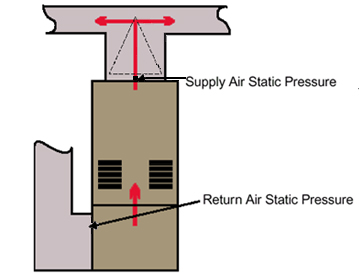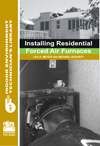If the blower speed is set too high for the application, the evaporator coil will not be able to do an adequate job of dehumidification, and may result in a customer complaint. If the blower speed is set too low, you risk “freezing” the evaporator coil, which could lead to compressor failure due to liquid refrigerant floodback. Therefore, it is imperative that the proper blower speed for air conditioning is used.
To determine the best speed to use for air conditioning for a particular application, you need to measure the total system external static pressure (or E.S.P.), and use the blower performance chart provided with the furnace (see Figure 1 for sample chart) to determine the best speed to use. For optimum performance, most manufacturers recommend that 400 cfm per ton of air conditioning should be used. For example, a 2-ton system should have 800 cfm of air moving through the evaporator coil.

External static pressure is a force that is pushing out in all directions on the duct system. Restrictions in the duct system such as undersized duct, dirty filters or evaporator coil, or closed or blocked registers will cause the external static pressure to rise. As external static pressure rises, the furnace blower’s ability to move air declines.Most residential furnaces are designed to deliver their rated airflow up to 0.5 inches wc total external static pressure.
Taking Measurements
A useful tool for measuring E.S.P. is a Magnehelic gauge with a 0-2 inch wc scale. To determine the total E.S.P., you need to measure both the supply and return static pressures.To measure the supply static pressure, connect the Magnehelic probe to the port marked “high” (Figure 2).

The probe should be inserted immediately off of the supply duct connection, underneath the evaporator coil if possible (Figure 3).

This will allow you to read the supply static and the resistance to airflow imposed by the evaporator coil, supply duct, fittings, and registers. A common supply static value for a properly designed supply duct system with a clean, dry evaporator coil is 0.3 to 0.35 inches wc.
To measure the return static pressure, connect the Magnehelic probe to the port marked “low.” The probe should be inserted between the return air filter and the furnace. This will allow you to read the return static and resistance to airflow imposed by the filter, return drop, return ductwork, fittings, and grilles. If access cannot be attained between the furnace and the filter, another great place to measure return static is through the blower deck (Figure 4).

The total external static pressure can be determined either by taking the supply and return statics individually and adding them, or simply by using two probes and noting the reading on the Magnehelic gauge (Figure 5).

Once the total E.S.P. has been determined, look at the blower performance chart (Figure 1) for the furnace or air handler model you are working on. The cfm being delivered will be where the E.S.P. reading intersects with the blower speed being used. Remember that 400 cfm per ton of air conditioning is the target value. If required, raise or lower cooling the blower speed. After a blower speed change, recheck the external static pressure and consult the blower performance chart to verify cfm.
If Charts Are Unavailable
If the manufacturer’s blower charts are not available for the furnace you are adding air conditioning to (or for belt drive furnaces), use the following procedure to determine an approximate cfm.Taking a few extra minutes to properly set up airflow for air conditioning on every installation will ensure the best possible customer comfort and equipment longevity, while eliminating unnecessary callbacks.
Nelmark is owner/multimedia developer of Axxess Media Interactive, Jackson, WI. He has 12 years of experience in the HVAC industry doing PC-based training of technicians on HVAC equipment installations. For more information, call 262-305-0545 or visit www.axxessmedia.com.
Publication date: 04/07/2003







